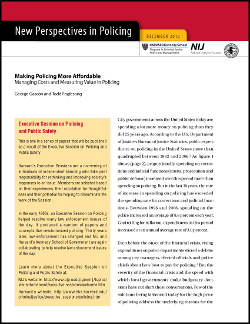
During the last 25 years, the costs of policing have risen dramatically across the nation. This rise in costs has spurred debates among city managers, elected officials, and police chiefs on how best to pay for policing - a debate that has only become sharper with the current fiscal crisis among state and local governments. This paper looks at the rising costs of policing in one medium-sized U.S. city (Mesa, Ariz.), and asks two major questions 1) What is driving up the costs of policing? 2) What return on their investment in policing are cities and their residents receiving?
The paper compares policing costs and returns for Mesa with other nearby cities in the vicinity of Phoenix and with other medium-sized cities across the country. It then considers strategies now being tested for managing the rising costs of policing, including efforts to cut spending, raise productivity, revalue the benefits of policing and reengineer operations.
The authors found two major components of rising policing costs: rising personnel costs and greater demand for policing services. Personnel costs have gone up both because of the need for more officers as populations grow and because of rising salaries and benefits as more police departments compete for more qualified officers. Demand for policing services has gone up even as crime rates have dropped, in part because of the increasing complexity of police work, both in terms of greater regulatory requirements and increasingly complex crimes such as cybercrime and identity theft. However, some evidence indicates that as policing costs have risen, the return on investment in policing also has risen, in terms of crime rates and response times to calls for service.
